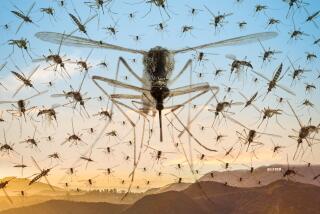Military, not the Internet, blamed for invasive cockroach
Don’t be quick to blame Internet commerce for the invasion of the Turkestan cockroaches in the Southwest. The insects are more likely the result of U.S. military entanglements in the Middle East and Central Asia, according to UC Riverside entomologists.
The Turkestan cockroach (Blatta lateralis) first appeared well before the public Internet existed -- in 1978, around the former Sharpe Army Depot in Lathrop, in California’s San Joaquin Valley. It soon showed up at Fort Bliss in El Paso, and several other bases, according to the UC researchers.
In the decades that followed, the bug simply out-bred and out-competed the more common Oriental cockroach (Blatta orientalis), according to UC Riverside entomologist Michael K. Rust, author of a study published Monday in the Journal of Economic Entomology.
“Our best guess right now is that this insect just breeds so much faster than the current pest species we have and it’s literally out-breeding it and probably out-competing it in its own environment,” Rust said.
Rust said he was surprised to find how readily available the roaches were on the Internet, where they are sold as food for reptiles, and suggested that such sales could accelerate the spread if the bugs are not handled properly. The bugs don’t easily escape glass aquariums because they can’t climb smooth surfaces, Rust noted.
Once established outdoors, the roaches tend to hang around in-ground containers such as water-meter, cable and irrigation boxes, according to the study authors. They also can be found in hollow block walls, under broken pavement and in expansion joints. All of those habitats are shared with Oriental cockroaches.
The roaches have been reported in L.A. Unifed schools at least since the late 1990s, according to Pest Control Technology magazine. At Cantara Street School in the San Fernando Valley, a 2003 infestation, since eradicated, revealed that 75% of the trapped roaches were Turkestan roaches -- a sign that they were displacing their competitors.
Rust, who specializes in urban insects, said he doesn’t expect the Turkestan roaches to be any more difficult to eradicate than their Blatta orientalis cousins.
“I don’t think that from a control perspective there will be a greater challenge,” he said. “If you find the breeding sites and get those baited, typically you get pretty good control.”
Still, UC Riverside laboratory experiments showed the Turkestan roaches can lay two to five times the number of egg masses of Blatta orientalis, and mature to adults much more quickly.
Turkestan cockroaches are native to a vast area from northern Africa to Central Asia.
The Oriental cockroach also was an invader that since has established itself worldwide. Like many species of cockroach, its name belies its origin: it is native to Africa, which also contributed the so-called American and German cockroaches.





